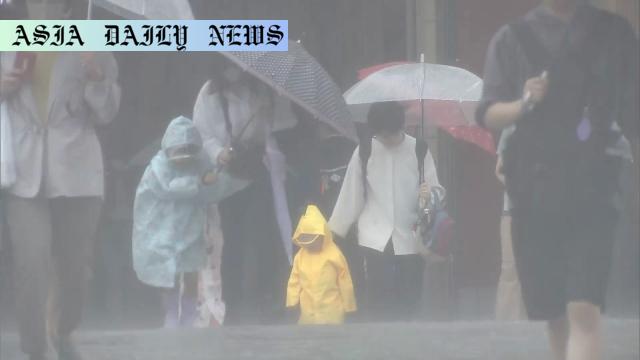Landslide Alerts issued as torrential downpours hit southwestern Japan, bringing record rainfalls and increasing landslide hazards.
Alert for Landslides issued in southwestern Japan following torrential downpours.
Forecast for up to 180mm of rainfall in Kyushu by Wednesday morning.
Heavy rains also mark rainy season arrival in Kanto-Koshin and Hokuriku.

Unstable Atmospheric Conditions Trigger Alerts
The southwestern regions of Japan are currently facing an onslaught of adverse weather conditions, driven by a seasonal rain front. The Japan Meteorological Agency has reported intermittent, yet heavy downpours affecting areas from northern Kyushu to Shikoku. The combination of warm, humid air and the stationary rain front has created highly unstable atmospheric conditions over both western and eastern Japan.
In localized areas like Amakusa City, Kumamoto Prefecture, and Kusu Town, Oita Prefecture, rainfall intensity has reached extreme levels of 38mm and 34mm within an hour, respectively. This torrential precipitation has heightened concerns regarding landslides, particularly in the prefectures of Fukuoka and Oita, where prior rainfall has already saturated the ground. Authorities have issued warnings to residents in these areas to remain alert to possible disasters.
Upcoming Rainfall Predictions and Regional Impacts
Weather forecasts indicate the rain front will persist in the vicinity of the Kyushu region until at least Wednesday morning. During this time, meteorologists warn of the possibility of a heavy rain cloud band forming over the region. This could result in extremely heavy rainfall, particularly in Fukuoka, Saga, Nagasaki, Oita, and Kumamoto prefectures. Projections suggest that rainfall totals might reach 180mm in northern Kyushu, 150mm in the Kinki region, and 120mm in both southern Kyushu and the Chugoku region by Wednesday morning.
The Japan Meteorological Agency has highlighted the elevated risk of flooding in low-lying areas and along rivers, as well as landslides in mountainous terrain. Moreover, localized regions in western and eastern Japan may also experience short-lived yet intense downpours accompanied by lightning, further compounding risks to public safety.
Rainy Season Commences in Eastern Japan
While western Japan grapples with extreme weather, the Kanto-Koshin and Hokuriku regions are seeing the onset of their annual rainy season. According to the weather agency, consistent precipitation and cloudy weather over the coming week signal this seasonal transition. Notably, the rainy season has arrived three days later than the historical norm in the Kanto-Koshin area but 11 days earlier than last year. Meanwhile, Hokuriku’s rainy season has begun one day earlier than usual and 12 days earlier than in 2024.
This shift in weather patterns underscores the importance of preparedness for residents in affected areas, particularly as the rainfall is expected to continue for at least seven more days. Emergency measures are being advised to mitigate damage caused by potential flooding and landslides.
Precautionary Measures Issued
Residents in northern Kyushu, where the brunt of the rainfall is anticipated, are urged to take precautionary measures to avoid disaster scenarios. These include staying informed through regular weather updates, preparing emergency supplies, and evacuating to safe grounds if necessary. Special attention is being given to low-lying flood-prone regions and steep slopes at risk of landslides.
Local governments and disaster management teams are on high alert, working to ensure the safety of citizens through timely alerts and evacuation orders. The Japan Meteorological Agency is continuously monitoring atmospheric conditions and will issue real-time updates as needed to minimize the impact of this weather event.
Commentary
The Critical Role of Weather Forecasting
This week’s heavy rainfall and the subsequent landslide alerts in southwestern Japan serve as poignant reminders of the importance of accurate and timely weather forecasting. Without the Japan Meteorological Agency’s diligent monitoring and prompt alerts, the potential for loss of life and property could be significantly higher. Advanced meteorological tools and modeling systems are pivotal in both predicting natural disasters and preparing emergency responses. Nonetheless, it is equally crucial for citizens to heed such warnings and act promptly for their safety.
Challenges Posed by Changing Rainfall Patterns
The volume and uneven distribution of rainfall in Japan this season also raise concerns over shifting climatic patterns. Areas like Kyushu, already prone to landslides due to its topography, face increased pressure as climate change intensifies. The unpredictability of these weather events necessitates not only disaster preparedness but also long-term strategies for sustainable land and urban planning. Governments and scientists must work together to mitigate vulnerabilities and better equip communities to face such crises.
A Time for Community Vigilance
In times of natural disasters, community cooperation becomes indispensable. As evacuation efforts begin in some parts of Kyushu, the importance of fostering a spirit of solidarity and mutual assistance cannot be overstated. Whether it’s checking on vulnerable neighbors or sharing resources, these small acts can make a huge difference in ensuring collective safety. At the same time, it is crucial to remain well-informed through authenticated sources to avoid panic or misinformation.
By reflecting on this week’s developments, we can better appreciate the need for individual and collective action in the face of natural adversities. Preparedness, vigilance, and cooperation will be key in navigating this challenging rainy season.


